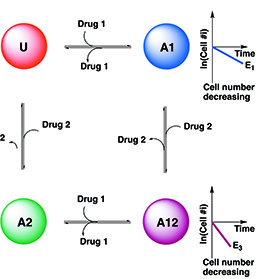 In recent years, the number of complex diseases such as cancer and drug resistant infections that are treated with multiple drugs has rapidly increased. Through combining drugs, one hopes to obtain synergy either by increasing potency (so the desired effect can be achieved with lower drug doses) or increasing efficacy (so greater maximum effect can be achieved). Clearly, a rational quantitative approach to selecting effective drug combinations would be highly advantageous; however, most approaches devised thus far do not distinguish between synergistic potency and synergistic efficacy, potentially leading to misleading conclusions. To address this need, Vanderbilt Basic Sciences investigator Vito Quaranta, his collaborator Christine Lovly (Department of Medicine, VUMC), and their laboratories developed the Multi-dimensional Synergy of Combinations (MuSyC) approach, which quantifies the effects of combining two drugs on the efficacy and potency of each. MuSyC is essentially a two-dimensional application of the Hill equation, which is typically used to evaluate drug potency (in terms of EC50) and efficacy (maximal response). MuSyC provides these two parameters for each individual drug in a combination along with α (a factor reflecting the effect of one drug on the potency of another) and β (a factor reflecting the efficacy of the combination relative to that of either drug alone). The researchers applied MuSyC to analyze the combination of 64 different drugs with osimertinib, an inhibitor of a mutant epidermal growth factor receptor found in some kinds of cancers. Screening the combinations in a non-small cell lung cancer cell line revealed that drugs of some classes (such as histone deacetylase inhibitors) tended to synergize with osimertinib, whereas those of other classes (such as mitogen activated protein kinase inhibitors) did not. Some combinations, such as ceritinib and osimertinib, produced synergistic efficacy that would likely not have been detected by many alternative approaches due to a decrease in potency. Further studies of the effects of combining BRAF and MEK inhibitors in BRAF mutant melanoma demonstrated that MuSyC could readily detect the value of this combination, which has proven to be effective in the clinic. The researchers also used MuSyC to identify gene expression patterns that lead to BRAF inhibitor resistance in melanoma cells. The findings led to the identification of a new drug combination of BRAF and NOX5 inhibitors that was effective in these resistant cells. Comparisons of MuSyC with three other methods for quantifying synergy in drug combinations demonstrated the superiority of the MuSyC approach. In many cases, the alternative approaches failed to identify promising combinations, and they all failed to distinguish effects on potency versus efficacy. In summary, the results demonstrate the value of MuSyC for the discovery and mechanistic analysis of synergistic drug combinations. We look forward to learning more from the application of MuSyC in future studies. The work is published in the Cell Systems.
In recent years, the number of complex diseases such as cancer and drug resistant infections that are treated with multiple drugs has rapidly increased. Through combining drugs, one hopes to obtain synergy either by increasing potency (so the desired effect can be achieved with lower drug doses) or increasing efficacy (so greater maximum effect can be achieved). Clearly, a rational quantitative approach to selecting effective drug combinations would be highly advantageous; however, most approaches devised thus far do not distinguish between synergistic potency and synergistic efficacy, potentially leading to misleading conclusions. To address this need, Vanderbilt Basic Sciences investigator Vito Quaranta, his collaborator Christine Lovly (Department of Medicine, VUMC), and their laboratories developed the Multi-dimensional Synergy of Combinations (MuSyC) approach, which quantifies the effects of combining two drugs on the efficacy and potency of each. MuSyC is essentially a two-dimensional application of the Hill equation, which is typically used to evaluate drug potency (in terms of EC50) and efficacy (maximal response). MuSyC provides these two parameters for each individual drug in a combination along with α (a factor reflecting the effect of one drug on the potency of another) and β (a factor reflecting the efficacy of the combination relative to that of either drug alone). The researchers applied MuSyC to analyze the combination of 64 different drugs with osimertinib, an inhibitor of a mutant epidermal growth factor receptor found in some kinds of cancers. Screening the combinations in a non-small cell lung cancer cell line revealed that drugs of some classes (such as histone deacetylase inhibitors) tended to synergize with osimertinib, whereas those of other classes (such as mitogen activated protein kinase inhibitors) did not. Some combinations, such as ceritinib and osimertinib, produced synergistic efficacy that would likely not have been detected by many alternative approaches due to a decrease in potency. Further studies of the effects of combining BRAF and MEK inhibitors in BRAF mutant melanoma demonstrated that MuSyC could readily detect the value of this combination, which has proven to be effective in the clinic. The researchers also used MuSyC to identify gene expression patterns that lead to BRAF inhibitor resistance in melanoma cells. The findings led to the identification of a new drug combination of BRAF and NOX5 inhibitors that was effective in these resistant cells. Comparisons of MuSyC with three other methods for quantifying synergy in drug combinations demonstrated the superiority of the MuSyC approach. In many cases, the alternative approaches failed to identify promising combinations, and they all failed to distinguish effects on potency versus efficacy. In summary, the results demonstrate the value of MuSyC for the discovery and mechanistic analysis of synergistic drug combinations. We look forward to learning more from the application of MuSyC in future studies. The work is published in the Cell Systems.